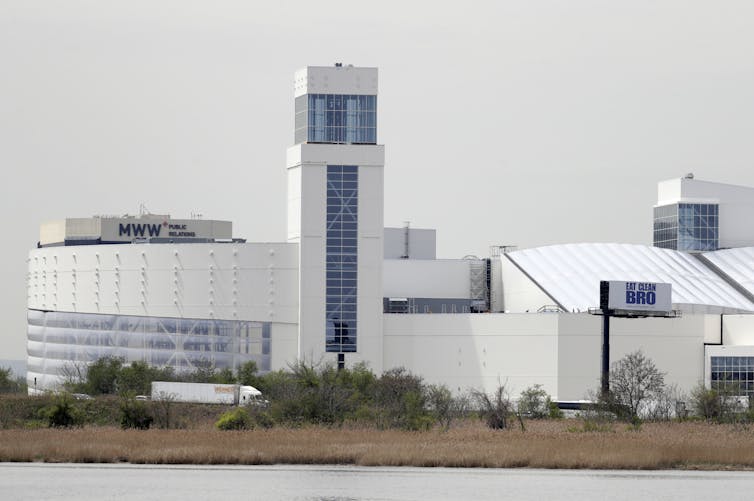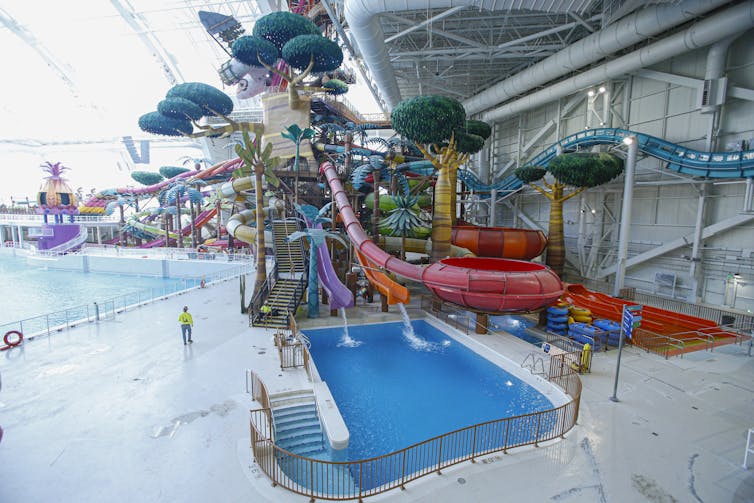The dystopian experience of skiing in New Jersey's new American Dream mall
- Written by Robert Snyder, Professor of Journalism and American Studies, Rutgers University Newark
In 50 years of skiing, my first downhill run of 2020 was like nothing I had ever experienced. The 28-degree temperature and machine-made snow were familiar enough, but I ended up skiing through a windowless rectangular box, beneath girders and electric lights, and toward a mural of a swank ski lodge.
I was at “Big Snow,” an indoor ski slope at the new American Dream Meadowlands, a mall and amusement park in East Rutherford, New Jersey.
Whether the vast project will actually deliver the crowds and dollars that its promoters anticipate[1] remains to be seen. Though amusements like Big Snow and Nickelodeon Universe are up and running, most of the mall’s stores and restaurants are set to open in March.
As a historian[2] and avid skier, what I find so jarring about the American Dream Meadowlands is the dissonance of its name and the timing of its completion. Its doors are opening just as malls around the country are shuttering, and as economic inequality and climate change have rendered the postwar vision of the American Dream[3] – modest but real prosperity, a better life for all and little luxuries like the Saturday ski trips that brightened my youth – ever harder to attain[4] for ordinary Americans.
Malls on life support
The broad prosperity of the United States’ postwar years was built on mass consumption[5] made possible by good wages – often won by unions – for working- and middle-class Americans. Malls[6], starting in the 1950s, were central to this enterprise.
As historian Lizabeth Cohen points out[7], malls were hardly innocent participants in the postwar economy: They drained shoppers, department stores and vitality from urban downtowns and suburban main streets. African Americans and Latinos in places like Newark, New Jersey, found themselves isolated[8] from the jobs and shopping opportunities found in malls, while their cities were sapped of tax revenue.
The economic growth that defined the postwar boom staggered[9] in the 1970s. When it resumed, it distributed wealth in ways that exacerbated economic inequality. By the 1990s, the security and social mobility that Americans once considered normal had withered[10].
Malls[11], meanwhile, experienced a steady and slow decline. Economic inequality weakened the middle class that long served as malls’ customer base. Then online shopping undermined the brick-and-mortar stores that populated malls. By the 21st century, the future of the traditional shopping mall was shaky at best[12].
Look no further than the fate of Macy’s. The department store that has long served as an “anchor[13]” for hundreds of malls announced[14] on Feb. 5 that it would close 125 stores in shopping centers across the United States.
Xanadu in the swamps of New Jersey
Nonetheless, in the Meadowlands American Dream forges on.
Developers broke ground in 2004[15] for its predecessor, a mall initially dubbed “Xanadu” after the pleasure dome in Samuel Taylor Coleridge’s poem “Kubla Khan[16].” Though its construction was halted by the 2008 recession, Xanadu was reborn[17] as American Dream Meadowlands, a US$5 billion development built by the Triple Five Group, the same Canadian firm that constructed the Mall of America in Minnesota. A joint series by WNYC, NJ Spotlight and Bloomberg Businessweek described[18] American Dream Meadowlands as “a labyrinth arrangement of private loans, bond sales, tax incentives and a public finance agency in Wisconsin.”
 The first portions of the mall finally opened in 2019 after nearly two decades of fits and starts.
AP Photo/Julio Cortez, File[19]
The first portions of the mall finally opened in 2019 after nearly two decades of fits and starts.
AP Photo/Julio Cortez, File[19]
If the financing of American Dream is byzantine, its rationale is straightforward. As shopping malls shut down because online retailing is siphoning off their customers, American Dream hopes to attract patrons by offering more amusements than stores.
The mall’s creators envision[20] that its pay-to-enter attractions like the DreamWorks Water Park and Big Snow – the first indoor ski hill in the U.S. – will be the draw that brings visitors, who will then go on to spend money in the stores. When visitors to American Dream shift from amusements to the task of shopping, they’ll have an array[21] of stores to choose from, ranging from Forever 21 to Hermes[22], where pocketbooks sell for thousands of dollars.
 The DreamWorks Water Park at the American Dream Meadowlands.
Kena Betancur/AFP via Getty Images[23]
The DreamWorks Water Park at the American Dream Meadowlands.
Kena Betancur/AFP via Getty Images[23]
I’m skeptical about the mall’s prospects. But beyond its profitability, there’s certain to be an environmental cost.
Think of the massive amounts of energy the mall will consume to keep Big Snow at 28 degrees year-round. And in an era when climate change and rising sea levels remind us of the importance of wetlands to absorb rain and storm surges, the mall slices off yet another piece of the Meadowlands[24], leaving the mall and the region around it more vulnerable to flooding[25].
The emptiness of big-box skiing
The skier in me keeps returning to the artificial slope. Global warming may be cutting into the length[26] of ski seasons[27].
But is the answer to build an artificially refrigerated ski slope on a wetlands?
Of course, outdoor downhill skiing is far from environmentally pure[28]. Badly cut trails[29] scar mountainsides, and at many ski resorts – with their slope side shops and condominiums – athletic pursuit long ago gave way to real estate development[30].
Yet of all the sports that boomed in the United States in the last century, skiing[31] offered people a special blend of grace, thrills and natural beauty.
The surge to the suburbs that redefined the United States in the prosperous decades after World War II was many things. But in part, it expressed a desire to live closer to nature[32]. While it’s easy to mock postwar suburban landscapes as “little boxes on a hillside[33],” the impulse to live with trees and a lawn deserves some sympathy. And for those who wanted more adventure in their lives than shoveling snow in the winter and mowing lawns in the summer, skiing offered a break from daily drudgery.
Downhill skiing, a product of postwar prosperity and the American Dream, never entirely transcended the limits of its time. Despite a significant number of African American skiers, they are not included in the sport’s public image – a problem summed up in a brilliant essay by historian Annie Gilbert Coleman titled “The Unbearable Whiteness of Skiing[34].”
But the sport nonetheless fostered community. Small, local resorts have long been part of the skiing scene in the New York metropolitan area[35], New England[36] and Colorado[37]. And cross-country skiing continues to offer natural snow and the silence of winter woodlands without the intrusions of ski lifts. The growth[38] in backcountry skiing in recent years is, in part, a reaction against crowded resorts and a desire to ski untracked terrain[39].
Most of my skiing is cross-country[40], which brings me to serene and remote places that I would never otherwise get to. Downhill gives me mountaintop vistas and manageable thrills. Big Snow provides none of these.
I left the American Dream Meadowlands bewildered. My muscles ached pleasantly the way they usually do after skiing, but I didn’t feel the sense of ease and satisfaction that I associate with a good day in the outdoors.
As I headed for my car, a construction worker laboring to finish the stores in time for their March opening asked me what Big Snow was like. I said it was different. He said that he liked to ski but was planning to go to Gore Mountain in the Adirondacks. I told him that was the better bet.
[ Deep knowledge, daily. Sign up for The Conversation’s newsletter[41]. ]
References
- ^ anticipate (www.americandream.com)
- ^ As a historian (www.newark.rutgers.edu)
- ^ American Dream (www.brookings.edu)
- ^ harder to attain (www.nber.org)
- ^ mass consumption (www.penguinrandomhouse.com)
- ^ Malls (www.njspotlight.com)
- ^ points out (dash.harvard.edu)
- ^ found themselves isolated (www.nytimes.com)
- ^ staggered (www.penguinrandomhouse.com)
- ^ had withered (www.nber.org)
- ^ Malls (www.theguardian.com)
- ^ shaky at best (time.com)
- ^ anchor (www.washingtonpost.com)
- ^ announced (www.wsj.com)
- ^ 2004 (www.nytimes.com)
- ^ Kubla Khan (www.poetryfoundation.org)
- ^ was reborn (www.nytimes.com)
- ^ described (www.njspotlight.com)
- ^ AP Photo/Julio Cortez, File (www.apimages.com)
- ^ envision (www.americandream.com)
- ^ array (www.businessinsider.com)
- ^ Hermes (www.hermes.com)
- ^ Kena Betancur/AFP via Getty Images (www.gettyimages.com)
- ^ Meadowlands (www.fws.gov)
- ^ more vulnerable to flooding (www.sierraclub.org)
- ^ length (www.cnbc.com)
- ^ ski seasons (www.climate.gov)
- ^ far from environmentally pure (kansaspress.ku.edu)
- ^ trails (pdfs.semanticscholar.org)
- ^ long ago gave way to real estate development (www.jstor.org)
- ^ skiing (kansaspress.ku.edu)
- ^ live closer to nature (www.doloreshayden.com)
- ^ little boxes on a hillside (www.youtube.com)
- ^ The Unbearable Whiteness of Skiing (www.jstor.org)
- ^ New York metropolitan area (www.timeout.com)
- ^ New England (www.boston.com)
- ^ Colorado (www.denverpost.com)
- ^ growth (sgbonline.com)
- ^ untracked terrain (granitebackcountryalliance.org)
- ^ cross-country (www.betatrails.org)
- ^ Sign up for The Conversation’s newsletter (theconversation.com)
Authors: Robert Snyder, Professor of Journalism and American Studies, Rutgers University Newark

